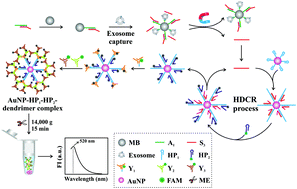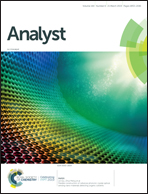A dual signal amplification method for exosome detection based on DNA dendrimer self-assembly†
Abstract
An increasing number of studies have found that circulating exosomes play a vital role in the occurrence and metastasis of cancer. Therefore, a direct, sensitive and specific method for detection of tumor exosomes will contribute to the diagnosis and prognosis of cancer. In this work, we take advantage of the facile adaptability of aptamers to design an exosome quantitative method, which converts an exosome capture event to nucleic acid detection. With the help of a hairpin DNA cascade reaction (HDCR) and easy accessibility of DNA dendrimer self-assembly, dual signal amplification was achieved. A CD63 aptamer linked via a DNA probe to magnetic beads acts as the capture component. In the presence of target exosomes, aptamers identify and combine with exosomes, releasing the DNA probe as a trigger to initiate the HDCR (the first signal amplification process) by opening hairpin DNA (HP1) bound to gold nanoparticles (AuNPs). Fluorescently-labeled DNA dendrimers concatenate with HP1 as the second signal amplification stage to increase the signal-to-noise ratio. Under the optimal conditions, our method achieved a good linear response for HepG2 cell-derived exosomes in a concentration range from 1.75 × 103 to 7.0 × 106 particles per μL with a detection limit of 1.16 × 103 particles per μL. It also shows a good performance for detection of exosomes in biological samples.



 Please wait while we load your content...
Please wait while we load your content...